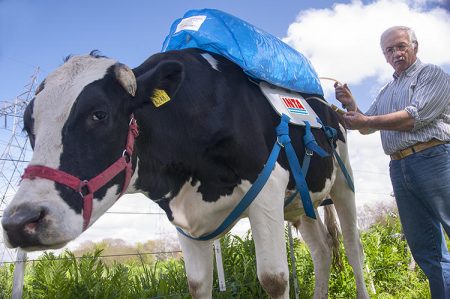December 3, 2016 – You may ask why would anyone want to capture the gas coming from the backsides of cows? Well the answer is – cows produce as much as 25% of global methane (CH4) emissions. So eliminating the gas from cow flatulence is a desirable thing to do.
Argentina’s National Institute of Agricultural Technology went about trying to come up with a CH4 capturing device and created a prototype device that can extract as much as 300 liters of the gas daily. That’s enough CH4 to run a fridge or car for a day. With over 51 million cows in the country, Argentina sees the potential to reduce greenhouse gas emissions from dairy and non-dairy cattle as worthwhile. Pablo Sorondo, press officer for the Institute sees a potential future where the gas collected from the cows could be used to provide all the energy needed to operate farms off the grid. Farms could even contribute power to nearby communities from the gas collected.
Is this for real? Well apparently the technology which involves a backpack with a tube inserted through the cow’s skin into its intestinal tract was first tested about three years ago. Once collected the gas was then compressed and condensed and used as fuel. But it appears that there is no hint of any ongoing development for the project at the National Institute’s website.
What it does, however, is illustrate a real challenge for livestock-based farming. The problem has been considered significant enough for California to sign into law a bill, SB 1383, aimed at addressing short-lived climate pollutants that includes regulating dairy and beef cattle sources for managing methane emissions. The bill doesn’t suggest anything as interventional as sticking a tube through the hide of a cow to capture the gas from its intestines, but rather refers to gas emissions after the fact describing innovation in manure management to harvest biomethane as an energy source. The goal is to reduce methane emissions from the dairy and livestock sectors by 40% from 2013 levels by 2030.











[…] is already commercially available, but issues remain with high costs and low conception rates. Collecting the methane produced by cattle could potentially reduce emissions both directly and by providing an alternative energy source to […]
[…] is already commercially available, but issues remain with high costs and low conception rates. Collecting the methane produced by cattle could potentially reduce emissions both directly and by providing an alternative energy source to […]